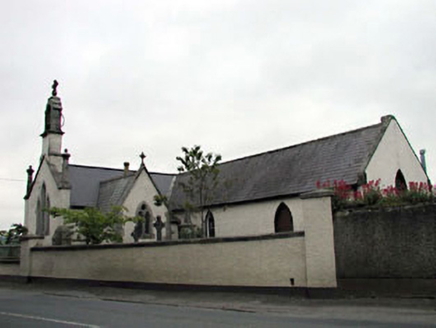Survey Data
Reg No
11902001
Rating
Regional
Categories of Special Interest
Architectural, Artistic, Historical, Social
Previous Name
Saint Mary's Catholic Church
Original Use
Church/chapel
In Use As
Church/chapel
Date
1820 - 1860
Coordinates
295073, 217821
Date Recorded
22/10/2002
Date Updated
--/--/--
Description
Detached five-bay single-storey Gothic-style Catholic church, c.1840, on a cruciform plan originally single-cell comprising four-bay single-storey nave with single-bay single-storey range to north-west having single-bay single-storey gabled sacristy projection to south-west, single-bay single-storey lean-to advanced porch to north-east and cut-stone bellcote to gable. Extended, c.1880, comprising two-bay single-storey elongated transept to south-west and three-bay single-storey elongated transept to north-east. Renovated, c.1980, with two-bay single-storey flat-roofed sacristy projection added to south-east range. Gable-ended roofs with slate (gabled to original sacristy projection; lean-to to porch). Clay ridge tiles. Cut-stone coping to gables (with pinnacles to north-west). Cut-stone bellcote to gable to north-west on roughcast base with cross finial to apex. Cast-iron rainwater goods on eaves course. Flat-roof to additional sacristy projection. Bitumen felt. Roughcast walls. Painted. Cut-stone dressings including stepped buttresses to north-west and quoins to original sacristy projection. Recessed panels to south-east range (possibly originally openings). Lancet-arch window openings. Stone sills. Fixed-pane timber windows. Cut-stone mullioned window to original sacristy projection. Tripartite window opening to north-west. Square-headed door opening to lean-to porch. Cut-stone shouldered surround. Tongue-and-groove timber panelled door. Lancet-arch door opening to north-east. Tongue-and-groove timber panelled door. Set back from road in own grounds on a corner site. Gravel grounds to site. Group of three cut-stone grave markers, c.1860, to north-west. Freestanding Marian grotto, c.1955, to site. Roughcast boundary wall to site with sections of iron railings.
Appraisal
The Catholic Church of the Immaculate Conception is a fine building on an unusual plan that reveals its evolution over the years. Despite the complexity of the plan, however, the elevations are simple in conception, with the exception of the north-westerly portion, and rely on the dispersion of simple lancet-arch openings for visual relief. The church is composed of long, low ranges typical of early post-Emancipation churches and the later additions reflect the growing prosperity of the Catholic community in the region - this is of considerable social and historic importance. The church has been well-maintained and retains much of its original features, materials and character. Of interest are the simple window fittings to the nave and transept, the original timber panelled doors, one of which retains decorative iron hinges, and the cut-stone dressings to the north-west. The bellcote, in particular, is a commanding feature and negates the need for a tower or spire, such is its impact on the skyline. The retention of further features such as the slate roof suggests that an interior of note may survive intact within. The church is attractively set just off the road side in its own grounds and forms a picturesque landmark on the corner site, forming the core of the village of Eadestown. Also of interest are the cut-stone grave markers to the north-west that are of some artistic merit.

